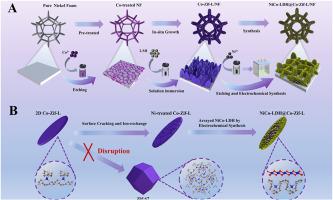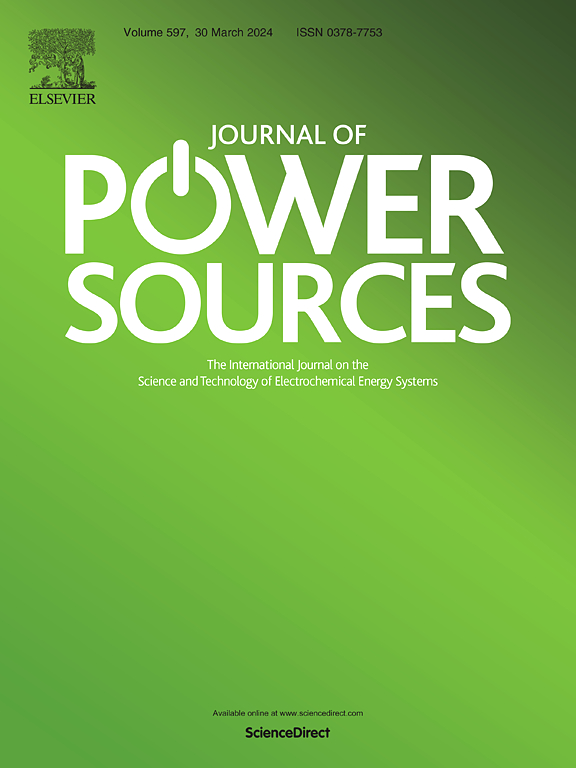Engineering to disrupt ZIF-67 formation: Novel strategy for constructing hierarchically three-dimensional NiCo-layered double Hydroxide@Co-ZIF-L composites for enhancing energy storage
IF 8.1
2区 工程技术
Q1 CHEMISTRY, PHYSICAL
引用次数: 0
Abstract
Effective design and construction of highly electrochemically active materials on conductive substrates with hierarchical nanostructures are critical for enhancing the electrochemical energy storage performance of electrodes. However, the design of such special structures is still challenging. In this study, a special three-dimensional@three-dimensional (3D@3D) NiCo-layered double hydroxide (NiCo-LDH) composite nanostructure is developed through the innovative approach of in-situ growth of arrayed Co-Zif-L on conductive substrate, disrupting the Zif-67 formation. This is followed by ion exchange process and electrochemical synthesis for growing 3D NiCo-LDH nanosheets. A unique structure with the 3D NiCo-LDH embedded in the 3D Co-Zif-L structure, termed as 3D@3D, is resulted. This spatial structure not only enhances their mechanical stability and adhesion strength through the in-situ growth process, but also provides a greater number of electrochemical active sites due to its ultra-large specific surface area. Density functional theory (DFT) calculations reveal that the NiCo-LDH@Co-Zif-L composite nanostructure exhibits an enhanced density of states (DOS) near the Fermi level compared to individual components, indicating excellent conductivity. With this unique structure, the NiCo-LDH@Co-Zif-L/NF electrode demonstrates an area-specific capacity of 4.1C cm−2 and retains 81.9 % of its initial capacitance after 5000 cycles. Moreover, the assembled hybrid supercapacitor achieves an energy density of 222.2 mWh cm−2 at a power density of 800 mW cm−2 (66.9 Wh kg−1 at 245 W/kg). The innovative approach in this work provides new insights into the utilization of Zif materials and designing electrode materials with special structures for high-performance electrochemical energy storage devices.

通过工程设计破坏 ZIF-67 的形成:构建分层三维镍钴层双氢氧化物@Co-ZIF-L复合材料以增强能量存储的新策略
在导电基底上有效设计和构建具有分层纳米结构的高电化学活性材料,对于提高电极的电化学储能性能至关重要。然而,这种特殊结构的设计仍然具有挑战性。在本研究中,通过在导电基底上原位生长阵列 Co-Zif-L、破坏 Zif-67 形成的创新方法,开发出了一种特殊的三维@三维(3D@3D)镍钴层状双氢氧化物(NiCo-LDH)复合纳米结构。随后,通过离子交换工艺和电化学合成技术生长出三维 NiCo-LDH 纳米片。这样就形成了一种独特的结构,即三维 NiCo-LDH 嵌入到三维 Co-Zif-L 结构中,这种结构被称为 3D@3D。这种空间结构不仅通过原位生长过程增强了其机械稳定性和粘附强度,还因其超大比表面积而提供了更多的电化学活性位点。密度泛函理论(DFT)计算显示,与单个成分相比,NiCo-LDH@Co-Zif-L 复合纳米结构在费米级附近显示出更高的状态密度(DOS),表明其具有优异的导电性。凭借这种独特的结构,NiCo-LDH@Co-Zif-L/NF 电极显示出 4.1C cm-2 的特定区域电容,并在 5000 次循环后保持了 81.9% 的初始电容。此外,组装后的混合超级电容器在功率密度为 800 mW cm-2 时的能量密度达到 222.2 mWh cm-2(245 W/kg 时为 66.9 Wh kg-1)。这项工作中的创新方法为利用 Zif 材料和为高性能电化学储能装置设计具有特殊结构的电极材料提供了新的思路。
本文章由计算机程序翻译,如有差异,请以英文原文为准。
求助全文
约1分钟内获得全文
求助全文
来源期刊

Journal of Power Sources
工程技术-电化学
CiteScore
16.40
自引率
6.50%
发文量
1249
审稿时长
36 days
期刊介绍:
The Journal of Power Sources is a publication catering to researchers and technologists interested in various aspects of the science, technology, and applications of electrochemical power sources. It covers original research and reviews on primary and secondary batteries, fuel cells, supercapacitors, and photo-electrochemical cells.
Topics considered include the research, development and applications of nanomaterials and novel componentry for these devices. Examples of applications of these electrochemical power sources include:
• Portable electronics
• Electric and Hybrid Electric Vehicles
• Uninterruptible Power Supply (UPS) systems
• Storage of renewable energy
• Satellites and deep space probes
• Boats and ships, drones and aircrafts
• Wearable energy storage systems
 求助内容:
求助内容: 应助结果提醒方式:
应助结果提醒方式:


